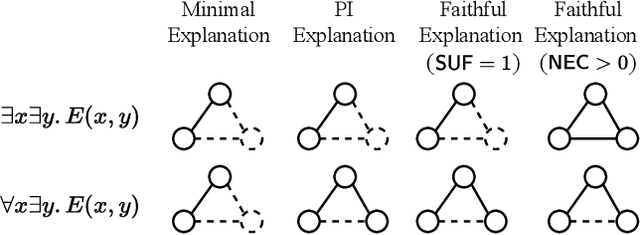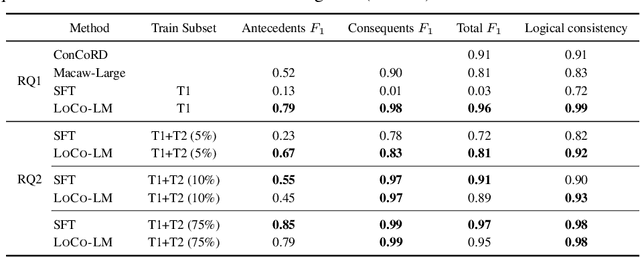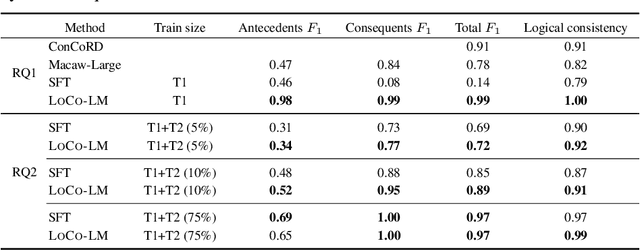Stefano Teso
Symbol Grounding in Neuro-Symbolic AI: A Gentle Introduction to Reasoning Shortcuts
Oct 16, 2025Abstract:Neuro-symbolic (NeSy) AI aims to develop deep neural networks whose predictions comply with prior knowledge encoding, e.g. safety or structural constraints. As such, it represents one of the most promising avenues for reliable and trustworthy AI. The core idea behind NeSy AI is to combine neural and symbolic steps: neural networks are typically responsible for mapping low-level inputs into high-level symbolic concepts, while symbolic reasoning infers predictions compatible with the extracted concepts and the prior knowledge. Despite their promise, it was recently shown that - whenever the concepts are not supervised directly - NeSy models can be affected by Reasoning Shortcuts (RSs). That is, they can achieve high label accuracy by grounding the concepts incorrectly. RSs can compromise the interpretability of the model's explanations, performance in out-of-distribution scenarios, and therefore reliability. At the same time, RSs are difficult to detect and prevent unless concept supervision is available, which is typically not the case. However, the literature on RSs is scattered, making it difficult for researchers and practitioners to understand and tackle this challenging problem. This overview addresses this issue by providing a gentle introduction to RSs, discussing their causes and consequences in intuitive terms. It also reviews and elucidates existing theoretical characterizations of this phenomenon. Finally, it details methods for dealing with RSs, including mitigation and awareness strategies, and maps their benefits and limitations. By reformulating advanced material in a digestible form, this overview aims to provide a unifying perspective on RSs to lower the bar to entry for tackling them. Ultimately, we hope this overview contributes to the development of reliable NeSy and trustworthy AI models.
Personalized Interpretability -- Interactive Alignment of Prototypical Parts Networks
Jun 05, 2025Abstract:Concept-based interpretable neural networks have gained significant attention due to their intuitive and easy-to-understand explanations based on case-based reasoning, such as "this bird looks like those sparrows". However, a major limitation is that these explanations may not always be comprehensible to users due to concept inconsistency, where multiple visual features are inappropriately mixed (e.g., a bird's head and wings treated as a single concept). This inconsistency breaks the alignment between model reasoning and human understanding. Furthermore, users have specific preferences for how concepts should look, yet current approaches provide no mechanism for incorporating their feedback. To address these issues, we introduce YoursProtoP, a novel interactive strategy that enables the personalization of prototypical parts - the visual concepts used by the model - according to user needs. By incorporating user supervision, YoursProtoP adapts and splits concepts used for both prediction and explanation to better match the user's preferences and understanding. Through experiments on both the synthetic FunnyBirds dataset and a real-world scenario using the CUB, CARS, and PETS datasets in a comprehensive user study, we demonstrate the effectiveness of YoursProtoP in achieving concept consistency without compromising the accuracy of the model.
If Concept Bottlenecks are the Question, are Foundation Models the Answer?
Apr 29, 2025Abstract:Concept Bottleneck Models (CBMs) are neural networks designed to conjoin high performance with ante-hoc interpretability. CBMs work by first mapping inputs (e.g., images) to high-level concepts (e.g., visible objects and their properties) and then use these to solve a downstream task (e.g., tagging or scoring an image) in an interpretable manner. Their performance and interpretability, however, hinge on the quality of the concepts they learn. The go-to strategy for ensuring good quality concepts is to leverage expert annotations, which are expensive to collect and seldom available in applications. Researchers have recently addressed this issue by introducing "VLM-CBM" architectures that replace manual annotations with weak supervision from foundation models. It is however unclear what is the impact of doing so on the quality of the learned concepts. To answer this question, we put state-of-the-art VLM-CBMs to the test, analyzing their learned concepts empirically using a selection of significant metrics. Our results show that, depending on the task, VLM supervision can sensibly differ from expert annotations, and that concept accuracy and quality are not strongly correlated. Our code is available at https://github.com/debryu/CQA.
Beyond Topological Self-Explainable GNNs: A Formal Explainability Perspective
Feb 04, 2025



Abstract:Self-Explainable Graph Neural Networks (SE-GNNs) are popular explainable-by-design GNNs, but the properties and the limitations of their explanations are not well understood. Our first contribution fills this gap by formalizing the explanations extracted by SE-GNNs, referred to as Trivial Explanations (TEs), and comparing them to established notions of explanations, namely Prime Implicant (PI) and faithful explanations. Our analysis reveals that TEs match PI explanations for a restricted but significant family of tasks. In general, however, they can be less informative than PI explanations and are surprisingly misaligned with widely accepted notions of faithfulness. Although faithful and PI explanations are informative, they are intractable to find and we show that they can be prohibitively large. Motivated by this, we propose Dual-Channel GNNs that integrate a white-box rule extractor and a standard SE-GNN, adaptively combining both channels when the task benefits. Our experiments show that even a simple instantiation of Dual-Channel GNNs can recover succinct rules and perform on par or better than widely used SE-GNNs. Our code can be found in the supplementary material.
Time Can Invalidate Algorithmic Recourse
Oct 10, 2024



Abstract:Algorithmic Recourse (AR) aims to provide users with actionable steps to overturn unfavourable decisions made by machine learning predictors. However, these actions often take time to implement (e.g., getting a degree can take years), and their effects may vary as the world evolves. Thus, it is natural to ask for recourse that remains valid in a dynamic environment. In this paper, we study the robustness of algorithmic recourse over time by casting the problem through the lens of causality. We demonstrate theoretically and empirically that (even robust) causal AR methods can fail over time except in the - unlikely - case that the world is stationary. Even more critically, unless the world is fully deterministic, counterfactual AR cannot be solved optimally. To account for this, we propose a simple yet effective algorithm for temporal AR that explicitly accounts for time. Our simulations on synthetic and realistic datasets show how considering time produces more resilient solutions to potential trends in the data distribution.
Spurious Correlations in Concept Drift: Can Explanatory Interaction Help?
Jul 23, 2024Abstract:Long-running machine learning models face the issue of concept drift (CD), whereby the data distribution changes over time, compromising prediction performance. Updating the model requires detecting drift by monitoring the data and/or the model for unexpected changes. We show that, however, spurious correlations (SCs) can spoil the statistics tracked by detection algorithms. Motivated by this, we introduce ebc-exstream, a novel detector that leverages model explanations to identify potential SCs and human feedback to correct for them. It leverages an entropy-based heuristic to reduce the amount of necessary feedback, cutting annotation costs. Our preliminary experiments on artificially confounded data highlight the promise of ebc-exstream for reducing the impact of SCs on detection.
Perks and Pitfalls of Faithfulness in Regular, Self-Explainable and Domain Invariant GNNs
Jun 21, 2024Abstract:As Graph Neural Networks (GNNs) become more pervasive, it becomes paramount to build robust tools for computing explanations of their predictions. A key desideratum is that these explanations are faithful, i.e., that they portray an accurate picture of the GNN's reasoning process. A number of different faithfulness metrics exist, begging the question of what faithfulness is exactly, and what its properties are. We begin by showing that existing metrics are not interchangeable -- i.e., explanations attaining high faithfulness according to one metric may be unfaithful according to others -- and can be systematically insensitive to important properties of the explanation, and suggest how to address these issues. We proceed to show that, surprisingly, optimizing for faithfulness is not always a sensible design goal. Specifically, we show that for injective regular GNN architectures, perfectly faithful explanations are completely uninformative. The situation is different for modular GNNs, such as self-explainable and domain-invariant architectures, where optimizing faithfulness does not compromise informativeness, and is also unexpectedly tied to out-of-distribution generalization.
A Benchmark Suite for Systematically Evaluating Reasoning Shortcuts
Jun 14, 2024



Abstract:The advent of powerful neural classifiers has increased interest in problems that require both learning and reasoning. These problems are critical for understanding important properties of models, such as trustworthiness, generalization, interpretability, and compliance to safety and structural constraints. However, recent research observed that tasks requiring both learning and reasoning on background knowledge often suffer from reasoning shortcuts (RSs): predictors can solve the downstream reasoning task without associating the correct concepts to the high-dimensional data. To address this issue, we introduce rsbench, a comprehensive benchmark suite designed to systematically evaluate the impact of RSs on models by providing easy access to highly customizable tasks affected by RSs. Furthermore, rsbench implements common metrics for evaluating concept quality and introduces novel formal verification procedures for assessing the presence of RSs in learning tasks. Using rsbench, we highlight that obtaining high quality concepts in both purely neural and neuro-symbolic models is a far-from-solved problem. rsbench is available at: https://unitn-sml.github.io/rsbench.
Semantic Loss Functions for Neuro-Symbolic Structured Prediction
May 12, 2024Abstract:Structured output prediction problems are ubiquitous in machine learning. The prominent approach leverages neural networks as powerful feature extractors, otherwise assuming the independence of the outputs. These outputs, however, jointly encode an object, e.g. a path in a graph, and are therefore related through the structure underlying the output space. We discuss the semantic loss, which injects knowledge about such structure, defined symbolically, into training by minimizing the network's violation of such dependencies, steering the network towards predicting distributions satisfying the underlying structure. At the same time, it is agnostic to the arrangement of the symbols, and depends only on the semantics expressed thereby, while also enabling efficient end-to-end training and inference. We also discuss key improvements and applications of the semantic loss. One limitations of the semantic loss is that it does not exploit the association of every data point with certain features certifying its membership in a target class. We should therefore prefer minimum-entropy distributions over valid structures, which we obtain by additionally minimizing the neuro-symbolic entropy. We empirically demonstrate the benefits of this more refined formulation. Moreover, the semantic loss is designed to be modular and can be combined with both discriminative and generative neural models. This is illustrated by integrating it into generative adversarial networks, yielding constrained adversarial networks, a novel class of deep generative models able to efficiently synthesize complex objects obeying the structure of the underlying domain.
Towards Logically Consistent Language Models via Probabilistic Reasoning
Apr 19, 2024



Abstract:Large language models (LLMs) are a promising venue for natural language understanding and generation tasks. However, current LLMs are far from reliable: they are prone to generate non-factual information and, more crucially, to contradict themselves when prompted to reason about beliefs of the world. These problems are currently addressed with large scale fine-tuning or by delegating consistent reasoning to external tools. In this work, we strive for a middle ground and introduce a training objective based on principled probabilistic reasoning that teaches a LLM to be consistent with external knowledge in the form of a set of facts and rules. Fine-tuning with our loss on a limited set of facts enables our LLMs to be more logically consistent than previous baselines and allows them to extrapolate to unseen but semantically similar factual knowledge more systematically.
 Add to Chrome
Add to Chrome Add to Firefox
Add to Firefox Add to Edge
Add to Edge